Tempered Outcomes And Shaken Faiths: The Beginning Of The End?
Part 3 of the ongoing 'The Coming Russian Offensive' series.
Growing Fears
It’s clearer than ever that the West is hitting the panic button. With increased solemnity, the Western ‘mainstream’ titans are souring in their reportage of the war like wilting dandelions—headlines not only reeling back the earlier pomp and machismo of a certified victory, but now striking notes of urgency and doubt into their clouding forecasts for the war’s future.
Almost in unison, they now agree that “the next 3 months” will be the “critical turning point of the war”, one way or another. Some Western factions are beginning to float out more than just ‘feelers’ to their audience, to acclimatize them to Ukraine’s ensuing defeat, but are full-blown preparing and conditioning them for the inevitable downgrade of expectations.
A rash of recent headlines have signaled this fact.
In macabre-like fashion, the war in Ukraine is devolving ever deeper into an unending abyss of death and destruction. Haunted early on by Russian crimes against humanity and civilian mass graves in Bucha and Izyum, this violent dance of death between Ukrainian and Russian soldiers is now, for a while, largely playing out in the fields and streets in and around Bakhmut and Kreminna – and elsewhere in the Donbas.
And the one that dropped the anvil hardest was yesterday’s Business Insider piece entitled: “Losses In Ukraine Are Out Of Proportion To What NATO’s Been Planning For, The Alliance Top General Says…”
The piece quotes a top NATO general who, bewilderedly, reels at the fact that the war has surpassed any and all ‘proportion’ that NATO is capable of managing.
NATO leaders have been worried by the heavy casualties and massive ammunition usage in Ukraine.
"The scale of this war is out of proportion with all of our recent thinking," NATO's top general said in January.
NATO’s Supreme Allied Commander of Europe, General Cavoli, said,
"The magnitude of this war is incredible. The Ukrainians have 37 frontline brigades, plus dozens more territorial brigades. The Russians have lost almost 2,000 tanks. If we average out since the beginning of the war, the slow days and fast days, the Russians have expended on average well over 20,000 artillery rounds per day. The scale of this war is out of proportion with all of our recent thinking."
Newsweek also now quotes former NATO Supreme Allied Commander Stavridis, who says that the war will end this year in a ‘Korean War’ style ending, along a demarcated DMZ line cutting Ukraine down the middle.
Of course he still manages to clothe his prognostication with some cope-swilling insinuations that the results of such a scenario would owe more to Russian weakness and failures of military objectives, rather than the more obvious admission that Ukraine’s own near-certain objectives of victory (reconquering Crimea, etc.) have gone up in smoke in the eyes of even the most ardent and fanatical NATO supporters.
This sentiment was echoed by none other than one of those very ‘fanaticists’, ex-presidential advisor Arestovich, who recently on his youtube podcast skittishly claimed that he believes the Korean War scenario is the most likely ending, because Ukraine simply “doesn’t have the resources” to continue such a war.
Dmitry Medvedev was even compelled to rebut the assertion:
Joining in the chorus of the suddenly gunshy, the cloaca of the DailyMail sputtered that the poor British military would be completely depleted of ammo in only a day against the Russian forces.
And that’s not hyperbole or a budget-milking ruse: we’ve already established here how the entirety of NATO’s ‘substantial’ productive engine churning on all ramped-up cylinders could barely hope to keep Ukraine’s bloated, paralytic corpse afloat.
But the newly approved Information Ministry directive spiraling down the Western echo-chamber sewage lines attempts to soften the blow with a Disney-esque re-imagining of the narrative. The analgesic to tide over the rabid horde of copium-huffers quivering in their unheated basements is now as follows: Ukraine will conduct a sweeping Spring-time offensive once the newly-annointed NATO wunderwaffen completes its lumbering steam-locomotive journey over Ukraine’s de-electrified railways. In essence, they’re saying: “Turn your eyes away, sweet child. The coming massacre won’t be a pretty sight…but worry not, in Spring time it’ll all get better. We promise! Have we lied before?”
Of course it is possible (what isn’t?) that such a thing could happen (feasible, not so much). Should Russian forces become bogged down into another relative positional, Strelkovian stalemate, and Ukraine manages to exhaust their offensive potential, it’s theoretically possible that some newly-raised reserves, outfitted with NATO’s latest, could turn the tables on a mired Russian force and regain some initiative. The crux will be the actual size of Russia’s newly mobilized force, and how well it performs.
But more and more, nervous indications from the West are pointing to an unprecedentedly large impending action.
Ukrainian military estimates #Russia has prepared 500,000 troops, 1,800 tanks, 3,950 armored vehicles, 2,700 artillery systems, 810 multiple-rocket-launch systems, 400 fighter jets, and 300 helicopters for the impending blitzkrieg 2.0.
These are the official numbers being trumpeted about in the Western press—and the enormity of the scale is certainly mouth-watering.
It should be mentioned, though, that some sources are greatly skeptical:
Andriy Chernyak told Kyiv Post that an attack from the territory of Belarus and a second attempt to take the capital Kyiv was “unlikely in the coming weeks”.
Many others in the West (and on Russia’s side) have expressed similar sentiments. However, one must recall that last year they had said the exact same thing on the eve of Feb. 24. It was U.S. intelligence, then, warning them of an impending attack, which Zelensky and others rubbished as unrealistic.
One must be sharp-eyed in discerning between western announcements which are psyops or diversion agendas, and those of genuine calls of alarm; the latter usually occuring when they have more to gain by telling the truth than lying.
Some profess that the West has major incentives for falsely decrying a coming ‘mass offensive’—namely that when the offensive doesn’t come, they can proclaim triumph with the narrative that the AFU had heroically repulsed Putin’s final ‘last ditch’ desperation effort. That is admittedly an enticing point. Certainly, it makes logical sense, and we admitted to the possibility back in Part 2, that Russia may very well choose to wait until later Spring, after rasputitsa.
Ultimately, however, the grave urgency of the coming tsunami of NATO’s renewed Lend Lease escalation likely far outweighs any other consideration—which is why Russia will most likely strike now, to behead the beast before it can regrow and gain inordinate strength.
Also—one should mention that, in the KyivPost headline above at least, the fineprint admission reads that an attack from Belarus onto Kiev is unlikely; they don’t seem to address the other attack routes.
Symbolic Dates
And though we’ve covered it last time, a few brief updates to the situation should be made.
Firstly, it’s now official that Putin will in fact deliver his ‘State of the Nation’ address to the federal assembly on February 21st.
This has foreboding significance because Putin’s last such address came in April of 2021, having oddly skipped the 2022 address due to the ongoing SMO. And Feb. 21 is ominously the same date Putin gave this historic speech announcing the recognition of LPR/DPR republics, which signaled the lead up to the SMO, announced only days later on Feb. 24. So, there’s a possibility Putin will use this anniversary date to announce the next anticipated escalation.
What’s most ominous, is that one would think any further military action no longer requires ‘explanation’—as we’re already in the midst of war—Russia’s forthcoming offensive should ideally be planned as ‘surprising’ as possible. So what kind of escalation could possibly compel Putin to feel another penitential ‘explanation’ is owed like last time?
We know Putin’s a soft-heart—he used last year’s historic speeches to, in effect, preemptively offer apology to the Ukrainian people, and amnesty to the soldiers who lay down their arms, dotingly emphasizing that Russia’s war is “not against [them]” but rather the leadership.
So, knowing his Orthodox piety would demand such gestures in extenuating circumstances, one can muse that perhaps something like the announcement of the order to destroy all Dnieper bridges, for example, would spur him to another televised bout of contrition, addressing the Ukrainian people with a heartfelt offer of explanation.
In short, only something of momentous import could require another historic ‘explanation’.
Of course, admittedly, this is just outright speculation. The speech could be nothing more than a generalized summary and casual ‘reminder’ to the Russian people, of the values and mission statements of the SMO. But, one can’t help but feel a slight ominous tinge to it all, falling so symbolically on that exact date, right as the world awaits with bated breath an historic escalation.
Onto the second thing: there’s been a recent spate of suggestive attacks by Russian forces. Reports have continued for several days now that Russian forces have shelled AFU positions in Sumy from across the Russian border. This is interesting and obviously suggestive of a possible ‘softening up’ operation for a potential Sumy incursion in the next phase, as per many of the forecasts, including our own from Part 2.
Then, there was a surprise advance by Russian forces in the east Kharkov region, resulting in the reported full capture of Dvorochne—a town just across the Oskil River (west bank), north of Kupyansk. This is intriguing as Russia did not officially control any territory west of the Oskil since the Sept. 2022 mass-pullback. So, again, this would correspond with the possible early Recon-In-Force beginnings of a soon-to-come full-fledged operation from the north, to retake the Kharkov region.
Neither of these small actions would normally be notable, but no such strikes on Sumy had occurred in many months, and the same goes for attacks on this region of Kharkov.
For whatever reason, though, AFU sources appear to be leaning more heavily towards an attack from the south, thus sending reinforcements to the Zaporozhe region. Several reports have now indicated that “tens of thousands of new Russian troops” are “gathering north of Mariupol.” Unfortunately, there’s no further elaboration—although one source specified this to mean there are now 30,000 there, over the previous 10,000. This would suggest a possible vector towards Ugledar and Marinka from the south in the coming offensive.
Foreseeing Outcomes
But what could a realistic expectation be of Russia’s forthcoming Operation Uranus redux? For instance, we’ve all seen the following thought-provoking image:
We can promptly strike off the ‘Decisive Ukrainian Victory’, the ‘Day 1 Borders Ukrainian Victory’, and the ‘Liberated LDPR Pyrrhic Ukrainian Victory’. The first two are utterly inconceivable. The third is remotely possible in some parallel world where Russian command staff completely drops the ball in an unprecedented way—but still highly unlikely.
Why can we be so certain? Many people were duly shocked by the unexpected suddenness of Russia’s mass withdrawal/retreat from the Kherson and Kharkov regions. It implanted a cognitive bugbear of sorts into their minds, resulting in the understandable lowering of expectations and growing skepticism and doubt regarding Russian military capabilities.
But as we’ve outlined in Part 1 of the series, those retreats were the result of Russia utilizing an exponentially smaller force than almost anyone believed, causing them to be overstretched in the ambitious early part of the SMO. Areas like Kherson/Kharkov became simply ‘holding areas’ held by a token garrison which they knew could not realistically stand against a concerted assault. In short, these areas were held as intentional ‘crumple-zones’.
But the faulty premise of these retreats unfortunately skewed the perceptions of many, which now poisons their critical thinking in regard to future operations, which would be conducted under drastically different circumstances.
If the numbers are accurate, Russia will have the numerical superiority for the first time in the war. Even should they somehow lose the offensive initiative in a given, high-density frontline, it’s no longer a possibility for Ukraine to create ‘force majeur’ strong enough to drive Russia back from their now-highly-entrenched Zaporozhe defense lines and “win back” the entire area north of Crimea (thereby nullifying Russia’s Crimean landbridge).
“But the new capabilities (GLSDB, Storm Shadows, etc.) will allow Ukraine to strike Crimea, destroying rear HQ’s and ammo storage!”
Theoretically, it’s possible that the AFU can obtain future long range precision weaponry capable of disabling the Kerch bridge, and make massive prolonged strikes down toward the landbridge corridor that passes through Melitopol, effectively blocking Crimea. But the set of precise circumstances which would be required in order for this to succeed are extremely remote.
Without going too far into details, the current GLSDB’s (150km) don’t have the range to hit Kerch Bridge (250km+ from AFU positions); only ATACMs would be able to do so. But ATACMs has many limitations which should allow Russian AD to intercept them much more handily than even HIMARs.
But we can devote a separate report to this scenario, as there is a lot of nuance that goes into it.
But of the three Russian victory types: which is most likely?
We know that the ‘Decisive Russian Victory’ is the supreme goal. This would achieve Russia’s main objectives and is almost without question what they’re currently pursuing.
We further know that the 3rd option, ‘Pyrrhic Russian Victory’ is essentially what Russia has now, i.e. if they make no further significant gains but hold what they have, this is the option they’d get.
Now let’s examine the difference between full ‘Decisive Russian Victory’ and just ‘Russian Victory’ (the second option).
If you’ll notice, the only difference between the two is the addition of the northern oblasts of Kharkov, Sumy, Chernihiv, Poltava, and Zaporozhe oblasts. With the size of the coming force, those should not pose a major problem to take. After all, Russia had previously taken most of them already with 1/5th the force (or less). And contrary to the Western propaganda that Russia was “defeated” and “chased out”, it in fact effected a professional and orderly retreat in early April, when the command had come down for total reorganization and reorientation of forces amid the pullback from Kiev, after clobbering the AFU in those regions. This was because command acknowledged that the force disposition was not great enough to achieve the most major objectives there, and would be better served being concentrated into the Donbass front.
The real problem in both the first two options, is the seizure of lands west of the Dnieper River. This consists of Dnieperpetrovsk, Nikolayev, and Odessa oblasts—not to mention Kherson city and the remainder of Kherson oblast. A direct seizure of those lands right now is not plausible whatsoever.
Firstly, an amphibious coastal assault (and mass airborne operation) to seize Odessa and establish a bridgehead is not going to happen. It’s simply impossible due to the D-Day levels of casualty risk. That coastal region of Ukraine is swarming with British SAS operating all manner of Harpoon, Neptune, sea-Brimstones, naval drones and mines.
So the other options are:
1. Capturing everything east of the Dnieper and marching across the bridges of Zaporozhe and Dnipro city to the west bank.
2. Coming in from Kiev and seizing everything down towards Odessa as discussed in the famed ‘Macgregor Axis’ from Part 2.
The major issue that makes the first option unrealistic is that, were Russian forces to capture all the Donbass and land east of the Dnieper, then the AFU would likely blow the Dnieper bridges themselves after a mass retreat, denying Russia the ability to cross. Fording an entire army via pontoons over the very wide Dnieper is not feasible, and would result in a bottlenecked killzone.
So really, the only possible option that could potentially seize those territories is #2. But the problem is, as outlined in Part 2, we don’t believe the Macgregor Axis will be used (at least not in the beginning).
So the only real way that remains for Russia to seize those territories is either to effect a full unconditional surrender of the AFU, such that the entire country becomes placed under de facto military occupation, and then Russia is free to go anywhere and take anything it wants.
OR, Russia would have to capture everything east of the Dnieper, wait for AFU to blow all the bridges—then do a mass re-orientation of the entire army back north through Belarus and again reprise the northern assault via the Kiev corridor, essentially enacting the ‘Macgregor Axis’ or middle vector. This would consist of surrounding Kiev, then marching southwest to cut off Vinnytsia, link with the Transnistrian garrison to create a landbridge, and cut off the entirety of the Odessa, Nikolayev, Cherkasy, Kirovohrad, and Kherson oblasts.
The problem with the ‘unconditional surrender’ option, is that this is highly unlikely to happen in the Donbass or ‘east of the Dnieper’ theater for the reason that for Russia to create the conditions of such a surrender, they would have to capture or destroy the vast majority (or entirety) of the AFU force. And this can only be effected by creating a cauldron to trap hundreds of thousands of the AFU.
But such a decisive cauldron is unlikely. Modern near-peer conflict appears to preclude fast-gain offensives as simply too many ISR capabilities abound to destroy large penetrating maneuvering forces. And so the more risk-averse, artillery-first pace Russia prefers to employ (thus far at least) would not allow them to fully ‘close the cauldron’ in time before the majority of the AFU escapes by way of retreat.
Of course, Russia will eventually complete a cauldron and capture the Donbass, but the vast bulk of the AFU will likely have retreated to the west of the Dnieper by then. And that would leave Russia with no other options BUT to re-start an entirely new offensive from Belarus (since AFU would likely blow the bridges after withdrawal) to now begin chasing the AFU through the lands west of the Dnieper.
There is one scenario we’ve outlined before that could prevent this. And that was the preferred option #3 from Part 2: Russia can launch their mass offensive in the Donbass direction, as we expect them to do, then—once the AFU has brought all reserves to bear to this climactic battle—Russia can blow all the Dnieper bridges via massive missile strikes, and trap the AFU main force on the eastern side.
It’s conceivable the soldiers themselves could still find ways to escape after that—crossing the Dnieper by way of boats, barges, ferries, etc., will not present insurmountable challenges. But the entirety of their heavy weapons stock would be irretrievably abandoned, since, as mentioned earlier, pontooning the Dnieper is impractical at that scale—we’re not talking about crossing a company or battalion, but the entire armed forces of Ukraine consisting of many corps and armies, with the attendant heavy weapons numbering in the thousands.
And should the majority of the manpower escape, leaving the heavy equipment, they could still mass-fortify the western lands and commit to a suicidal defense and further war of attrition. Western equipment supplies could continue flooding in unabated and re-arm them while Russia slowly re-routes its entire army through the north (a process that could take MONTHS as it did in the April re-orientations).
This time period would allow the AFU to re-arm with heavy weapons if Russia still doesn’t take any initiative to staunch the flow of supplies from the West by that point—and such initiative would be unlikely anyway, as there is no single way (like cutting the bridges) to stop flows from Poland. The only definitive option would be a massive invading force to completely cut the far-western portion of Ukraine off.
One can see the numerous complications. There appear strong chances that the decisive outcome of “unconditional surrender” or “total destruction” in THIS present phase of the war will not occur. Russia could throw caution to the wind, or have such unforeseen and drastic numerical superiority (if rumors of stealth mobilization are true) that advances take on an unprecedented lightning tempo, and manage to create a Donbass cauldron quickly enough to prevent the AFU from escaping. However, that feels questionable, given the current state of the conflict and certain notable deficiencies that continue to hamper Russian efforts: namely a large fleet of effective UCAV strike drones, for one.
Or, there’s the possibility that even should a large part of the AFU escape to the west of the Dnieper, morale or some other form of collapse (coup d’etat, etc.) could bring about a surrender, but the chances of that are not great either, as western psyop/propaganda/CIA control of Kiev’s regime would do everything in their considerable power to prevent it, keeping the corpse afloat Weekend-At-Bernie’s-style.
Concluding Thoughts
We’ve outlined the possible scenarios, and how a massive reorientation of Russia’s army to the west of the Dnieper would likely be required at some point. But there are some lingering doubts as to how long Russia could prosecute such an offensive, chasing the AFU further and further west, into increasingly diminishing enclaves.
One view is that, should Russia conquer the entirety of lands east of the Dnieper, the army would be so exhausted as to be compelled into signing a new Minsk 3-equivalent compromise, i.e. the earlier mentioned ‘Korean Scenario’, which would split Ukraine along the Dnieper.
The pressure from the west, by this point, would be at maximum peak to ‘cut their losses’ and coerce, trick, finagle, and bribe the Kremlin with every possible tool at their disposal into signing such an agreement.
We all hear the homilies about the ‘existential nature’ of this conflict for Russia—and they’re true. But, there’s also the nagging concern that Putin’s actions thus far have not demonstrated the urgency commensurate with such vaunted proclamations. Much perplexity abounds about the Russian command’s continually ‘soft-handed’ approach, which sometimes seems to privilege Ukrainian civilians or ‘western sentiments’ over that of Russian military objectives/successes/soldiers; the Dnieper bridges issue being chief amongst these points.
So, the big question remains, would Russia and its leadership really have the needed gumption and existential drive to take this thing all the way to the finish in such a decisive way described above?
For now, it remains uncertain; and there does exist a chance of the dreaded half-way measure coming to pass, small as it may be. This would be a combination of ‘Russian Pyrrhic Victory’ and ‘Russian Decisive Victory’ from the earlier graphic, as they would not have Odessa or the coast, but would likely have everything east of the Dnieper.
Should the Russian offensive actually come soon, and if it is prosecuted in such a way as to demonstrate a new doctrinal determination toward victory without compromise, then we could confidently give the warrant of support for the ‘Full Decisive Victory’ scenario. Recall that Gerasimov himself has now been put in charge of operations, and a reshuffling of the general staff and high command has occurred, which bodes well, and does point to doctrinal shifts, tectonic or not.
Thus, if the early optics of the offensive demonstrate a newly iron-fisted doctrinal approach, our confidence in full victory will be unequivocal. But if signs of weak-willed pussy-footing and compromise continue, then chances greatly rise that some aforementioned combination of Pyrrhic victories could result.
After all—for those skeptical—recall that the exact farce has already played out before. In the 90’s Russia was forced to end the first Chechen war into a kind of awkward stalemate, only to continue it again later with the second, much bloodier conflict.
And recall that Arestovich predicted this very thing for exactly the reasons we contend. Think what you may of him—and certainly he is an oddball, conniving, duplicitous, deviant character—but a highly intelligent one. In fact, he may be the most intelligent mastermind in the entire echelons of AFU leadership, on an intellectual and philosophical basis.
In his now-famous early 2019 interview, he foresaw the entirety of the conflict with a startling clarity, predicting the war with Russia would come in 2021 or 2022, and even accurately outlining the exact vectors and tactics employed. But the less noticed blip which flew under the radar, was the mention of a second war in 2024-2025 (and a potential third in 2028).
Reading between the lines, the unspoken implication is that of the Chechen scenario. Arestovich keenly foresaw the possibility of the first war in 2022 ending indecisively, which would necessarily be followed by a period of shaky ‘truces’ (Mink 3, etc.) and customary rearmament via floods of new western arms, then the inevitable re-igniting of conflict a couple years later.
Though he doesn’t specify exactly, it’s obvious to the keen-eyed that he foresaw the predictable circumstance of a more localized Russian victory around Donbass, with the eventual exhaustion of Russian strategic initiative and inability to ‘finish off’ the remainder of what is effectively the largest country in Europe.
Now, (circling back to the beginning) Arestovich proclaims the likelihood of a ‘Korean’ DMZ scenario in his latest videos. And though we jump to characterize it as an admission of defeat on his behalf, it is in actuality in line with his original thesis from 2019—the brief armistice, followed by re-armament and subsequent war.
But to reiterate—the opening of the coming next phase of operations will clarify for us Russia’s posture and how seriously the Kremlin has committed to the deepest strategic objectives, and the signs so far are hopeful.
A few promising developments of late: Firstly, Russia has finally begun hitting the actual irreplaceable turbine rooms of the thermal power plants during the last two series of missile strikes. Previously, they mostly only hit substations and transformers located well outside the plants, which are readily replaced by shipments from Azerbaijan and elsewhere. This constitutes a major escalation towards neutralizing key Ukrainian infrastructure, and an apparent shift in doctrine.
And though they’ve hit it before, long ago, yesterday’s unexpected naval-drone strike on the Zatoka bridge in Odessa, which entirely severs Ukrainian rail from at least the Romanian direction, gives us another glimpse of a potential forthcoming doctrinal upgrade.
In the end, now all we can do is wait. The early indicators of the next offensive should give us a lot of signals for determining Russia’s posture of commitment, and which ‘victory scenario’ is most likely. Though we should give it time, because there is a strong chance that, even if the ‘big arrow’ style offensive comes, it may come in several waves or phases.
It would be strategically logical to first start in one direction (like the southern one where reports of build-ups have been accumulating) in order to drive Ukrainian reserves and trap them there—THEN attack en masse from the other direction (like the north) days/weeks later.
For now we’ll gather more data and see if new indications can bring us closer to clarity by the next report.





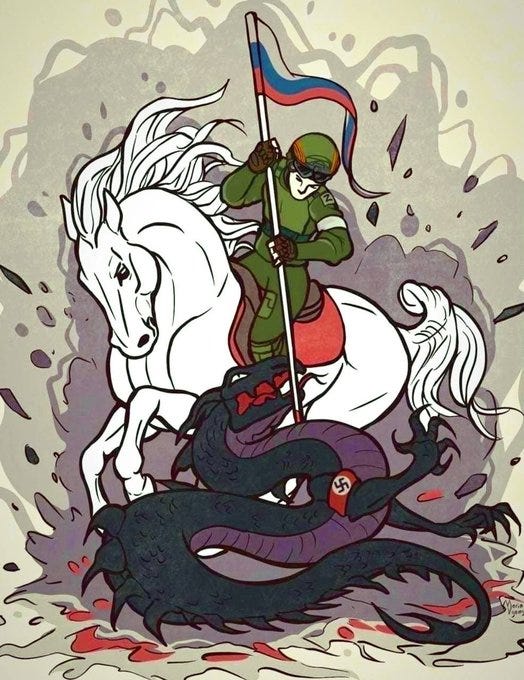
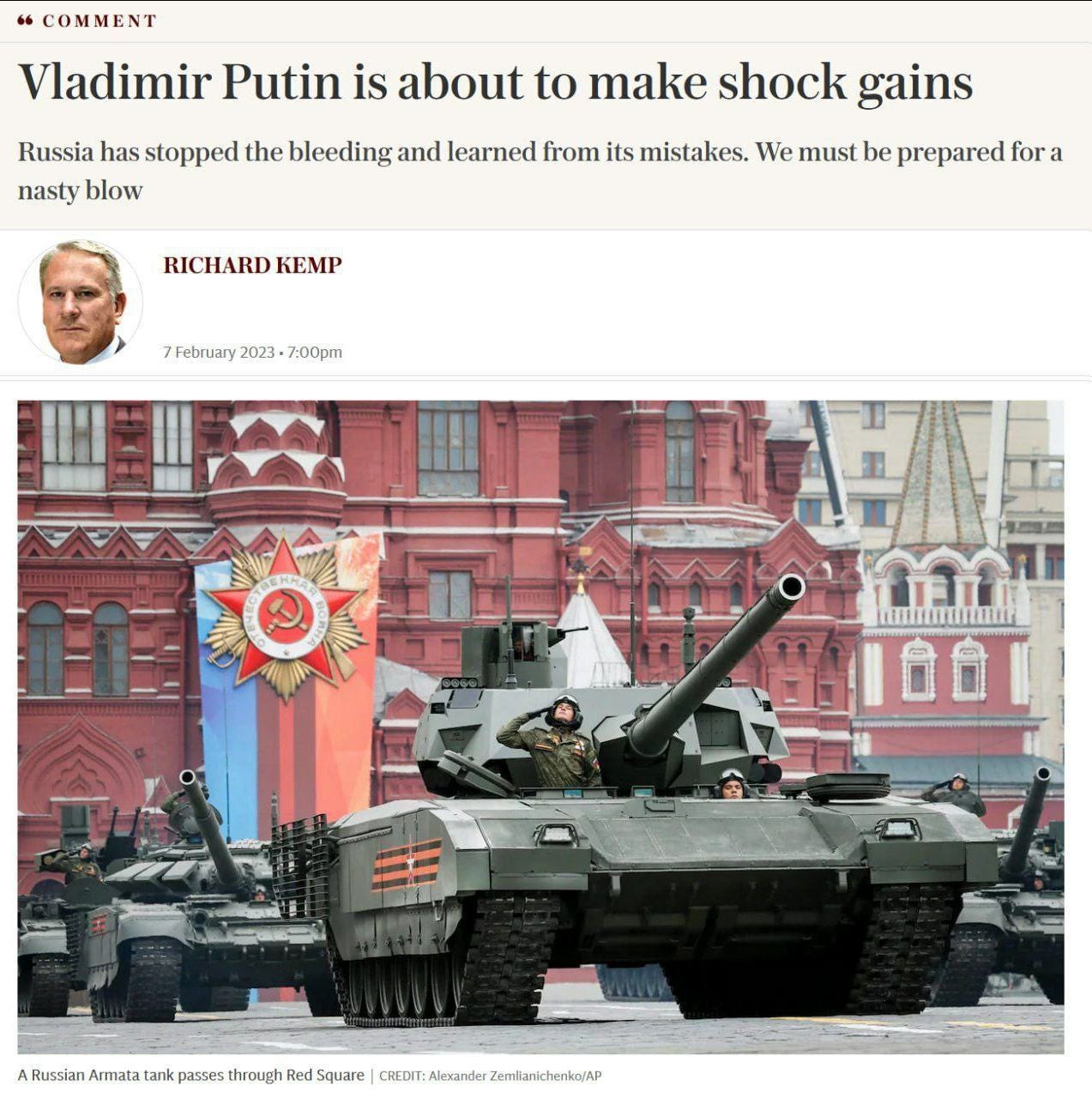



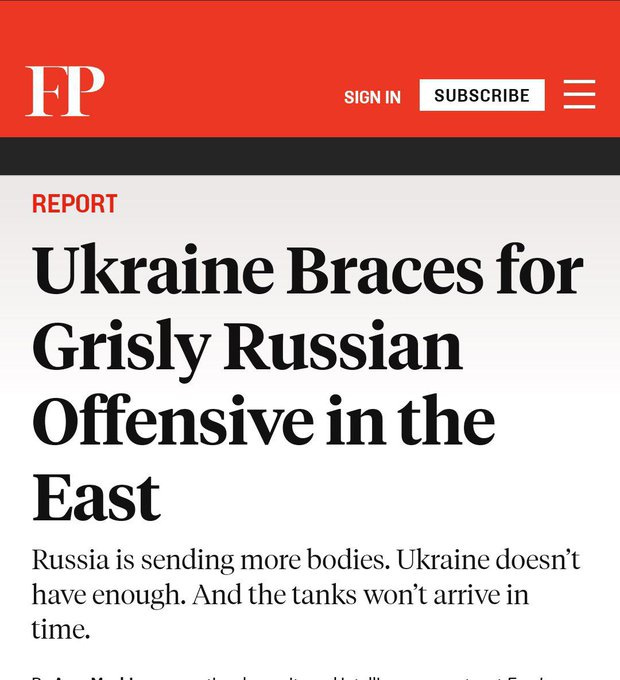

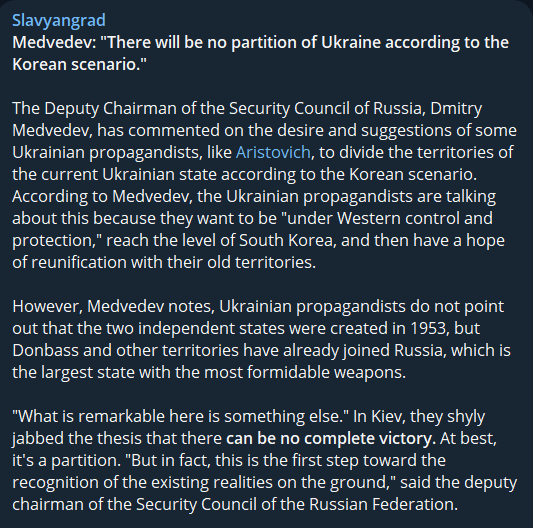
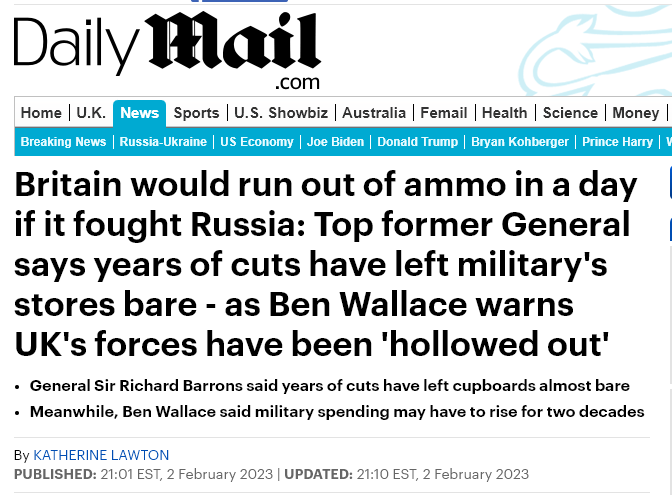

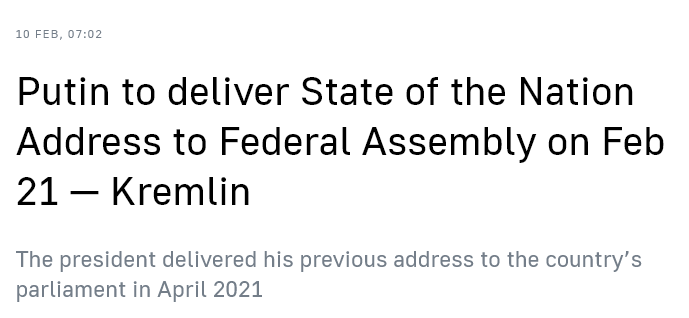
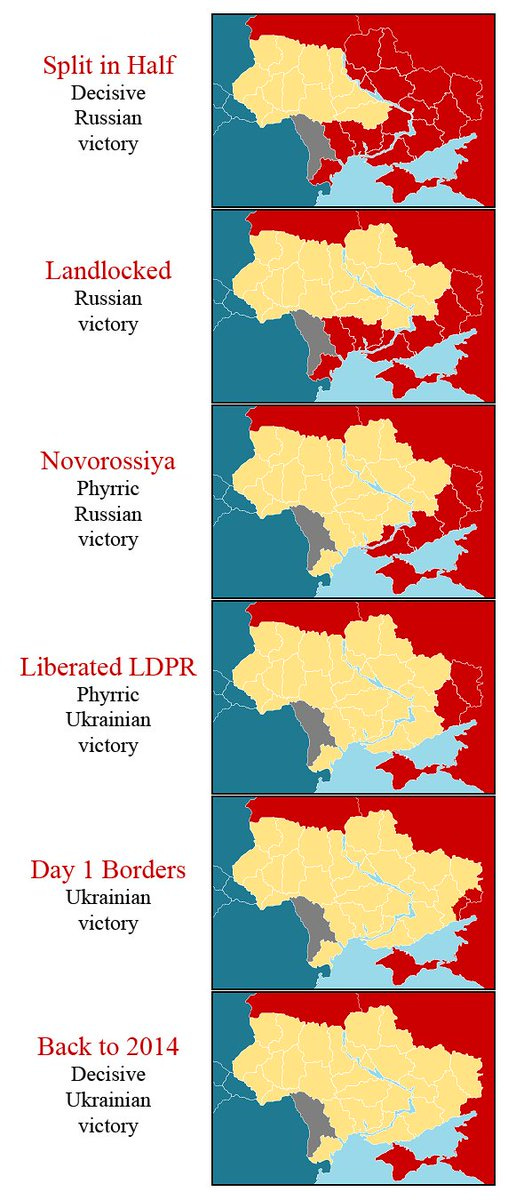
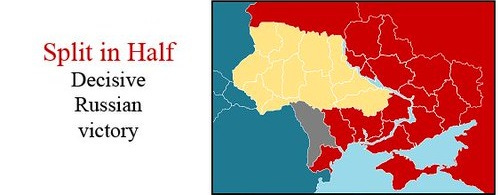
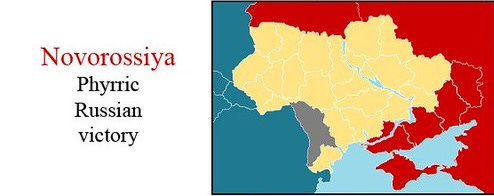
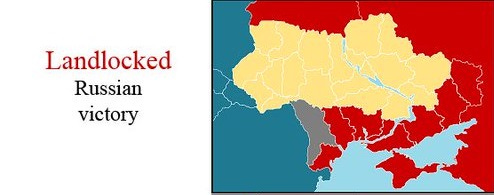
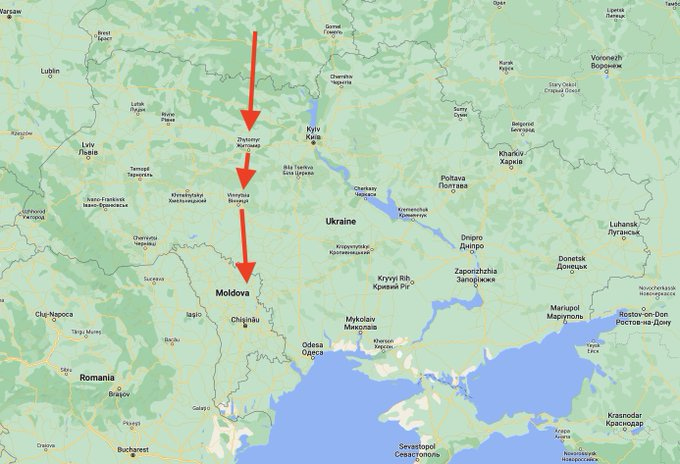
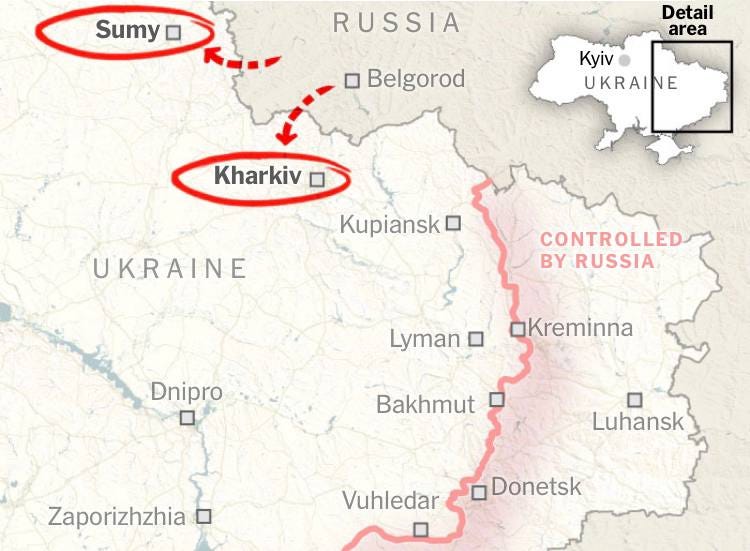

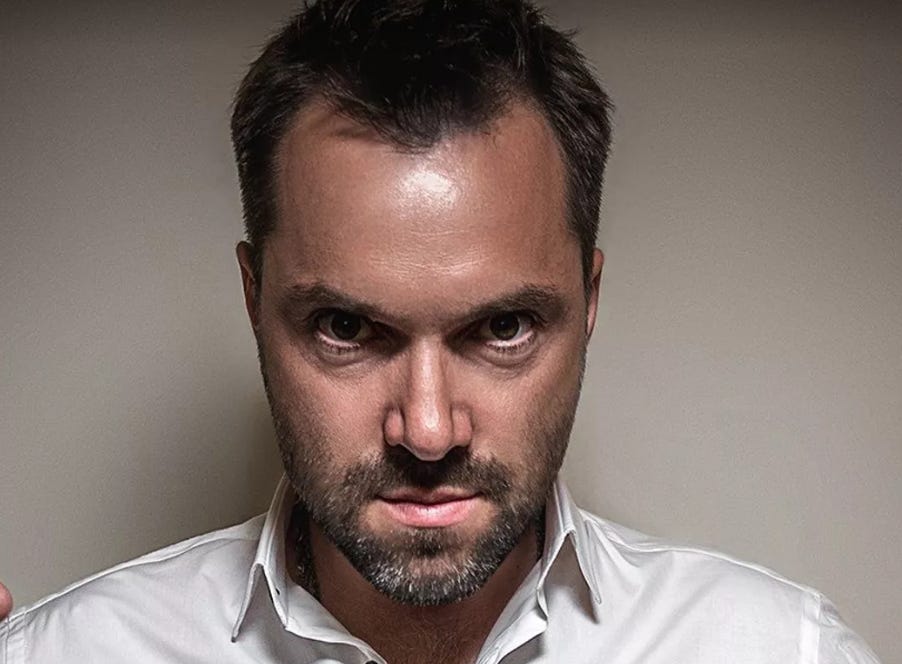
Russia is not warring Ukraine.
Russia is not invading Ukraine.
Russia is pushing back NATO ... while ... warring Emperor , to end his 5 centuries malfeasance fo good.
Ukraine is just a battlefield.
The main battlefield is in the cutting of Emperor's gravy train.
War will end when de-dollarization bankrupt US.
Until then , in Ukraine Russia will just grind forthcoming NATO.
The "offensive" will just push nazis back enough to secure civilians of LDPR, Melitopole and Belgorod (take Kharkov).
Don't hold your breath ... by far the most important battlefield is in de-dollarization ... that's what will crush Emperor and his provincial army NATO.
We're definitely seeing a lot of shaping going on across the front. Gerasimov's team have done a masterful job of keeping everyone guessing as to their intentions. Regardless of how decisively or not they can convert this effort, the Ukraine cannot fall into failed state status with some sort of frozen conflict in place to allow NATO a pause.